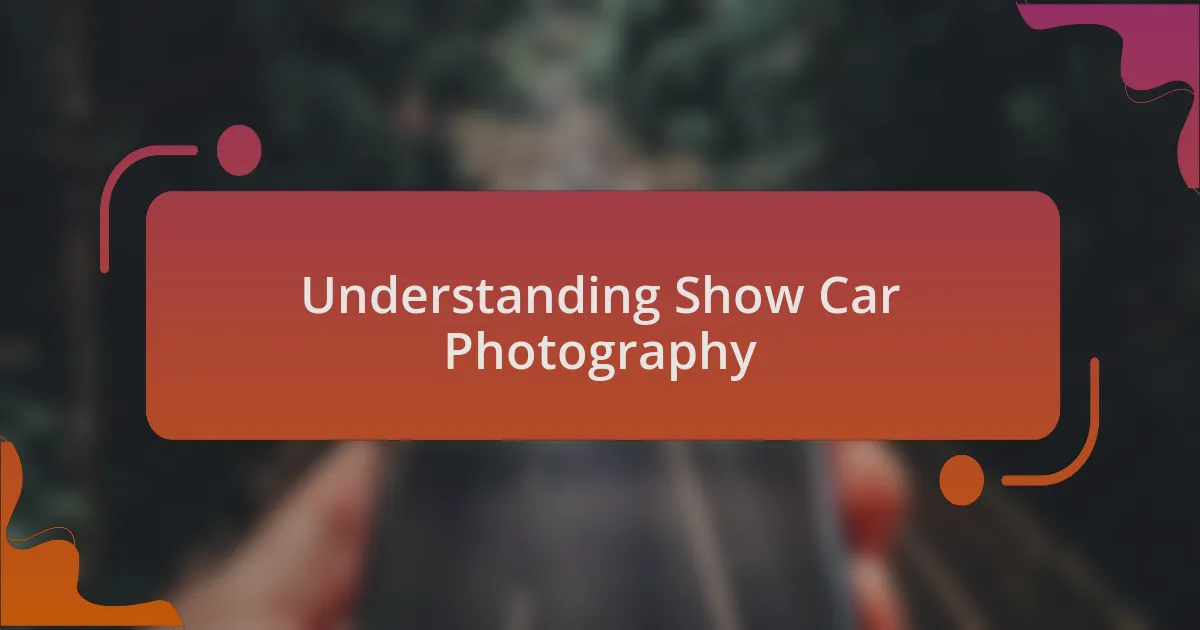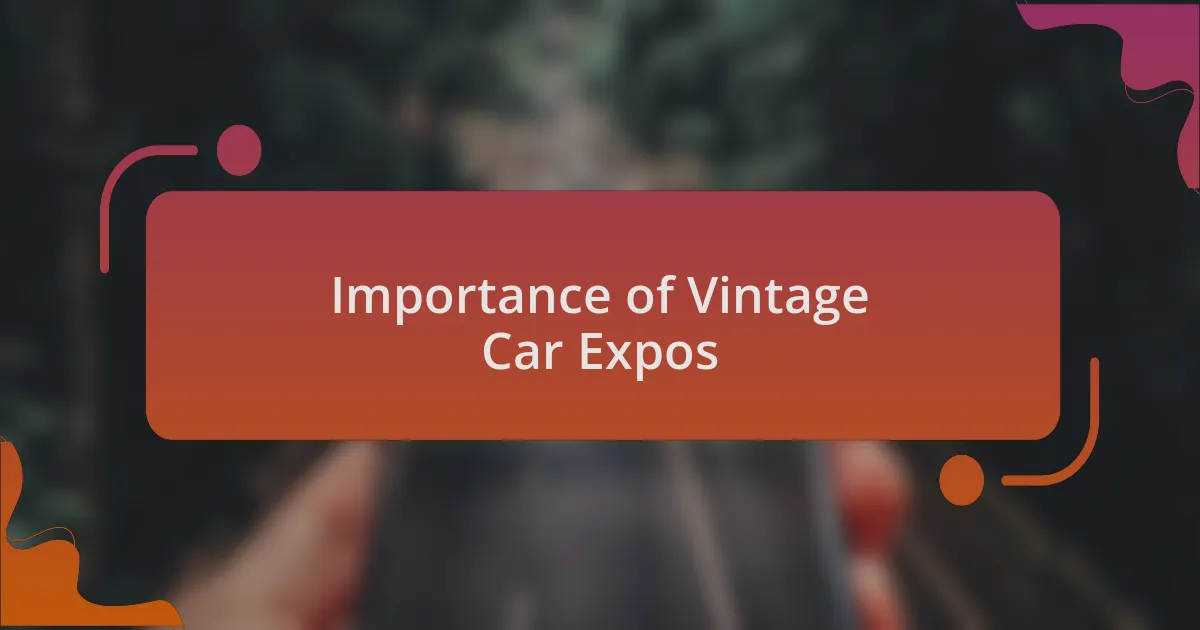Key takeaways:
- Show car photography emphasizes unique vehicle characteristics and storytelling through the right angles and lighting.
- Vintage car expos create community among enthusiasts and preserve automotive heritage, highlighting the artistry and history behind classic cars.
- Techniques such as using soft natural light and shallow depth of field enhance the visual impact of car photography.
- Experimenting with angles, reflections, and backgrounds can transform ordinary shots into extraordinary compositions that evoke nostalgia.

Understanding Show Car Photography
Capturing show car photography is all about highlighting the vehicle’s unique characteristics while also telling a story. I remember my first attempt at photographing a classic Mustang; I was overwhelmed by its sleek lines and vibrant color. I couldn’t help but wonder, “How can I make this car look as stunning on camera as it does in real life?” The key lies in choosing the right angles and lighting to showcase the car’s design.
There’s an undeniable emotional connection when photographing show cars. I often find myself reminiscing about the craftsmanship and history behind each model. Every vehicle has its own tale, and it’s my job to express that visually. For instance, capturing the sun glinting off the chrome details of a vintage Chevy not only accentuates its beauty but also evokes nostalgia for a bygone era.
Understanding the technical aspects is just as crucial. I’ve learned that using a wide aperture can create that dreamy background blur that makes the car pop. However, the essence of show car photography goes beyond mere technique; it’s about conveying passion. How can you reflect your love for cars in your shots? Experimentation has often led me to surprising results, and it’s taught me that each session is a chance to learn and adapt.

Importance of Vintage Car Expos
Vintage car expos hold a special place in the automotive world, as they act as cultural showcases for both enthusiasts and the general public. I remember attending my first expo, where the sheer diversity of classic cars left me in awe. Each vehicle, from muscle cars to vintage European models, tells a story that transports us back in time. Isn’t it fascinating how these events celebrate not just the cars, but the very essence of automotive history?
Furthermore, these expos foster a strong community among car lovers. I’ve met so many passionate individuals at these events who share their experiences and knowledge about their favorite models. It’s a unique opportunity to connect with others who appreciate the artistry and engineering behind vintage cars. Don’t you find that camaraderie inspiring? The conversations spark new ideas and often lead to collaborations among enthusiasts, photographers, and restorers.
Additionally, vintage car expos play a crucial role in preserving automotive heritage. By showcasing these timeless vehicles, we’re reminded of the innovation and craftsmanship that shaped the industry. I’ve often felt a sense of responsibility to capture these moments through photography and share them with a wider audience. How can we ensure future generations appreciate these masterpieces? It starts with honoring their legacy today, and these expos are a vital step in that direction.

Techniques for Capturing Show Cars
Capturing show cars requires a balance of lighting and angles to showcase their best features. I’ve found that early mornings or late afternoons offer the softest natural light, reducing harsh shadows and allowing the car’s contours to shine. It’s almost magical how the right light can reveal the metallic sheen of a classic finish—don’t you just love that glow?
When I’m composing a shot, my goal is to highlight the unique characteristics of each vehicle. Instead of simply framing the car, I often focus on interesting details, like the intricate designs of the grill or the timeless style of the tail fins. These elements tell a story, inviting viewers into the beauty of the vintage model. Have you ever caught yourself admiring those distinct features that make each car unique?
Using a shallow depth of field can make the car pop against a blurred background, which I find particularly effective at expos filled with other vehicles. By emphasizing the subject, I create a sense of intimacy, drawing the viewer into the image. It’s rewarding to see the reaction of others when they get lost in the details, as if they are standing beside that car in the expo. Wouldn’t you agree that such a striking perspective can transport someone right into the heart of automotive nostalgia?

Tips for Perfecting Your Shots
Finding the right angle can transform an ordinary photo into something extraordinary. I remember one particular show where I crouched down low to capture a classic muscle car from the ground up. The result was exhilarating; the car seemed to tower majestically in the frame, evoking the power and thrill it promised. Have you ever tried a different perspective that completely changed the way you saw a vehicle?
Experimenting with reflections can also add a stunning layer of creativity to your shots. One time, I noticed how the chrome accents of a vintage Cadillac beautifully mirrored the surrounding environment, enhancing the photograph’s depth. This layering invited viewers into a world where the car wasn’t just a mechanical marvel, but part of a larger story. Wouldn’t it be fun to look for these hidden reflections in your own shots?
Don’t underestimate the influence of the background on your photographs. I often scout locations that complement the vintage aesthetic of the car. Once, I found an old brick wall that perfectly contrasted a bright red convertible. The image wasn’t just about the car; it became a vibrant tribute to a bygone era. What locations have you discovered that elevate your car photography?